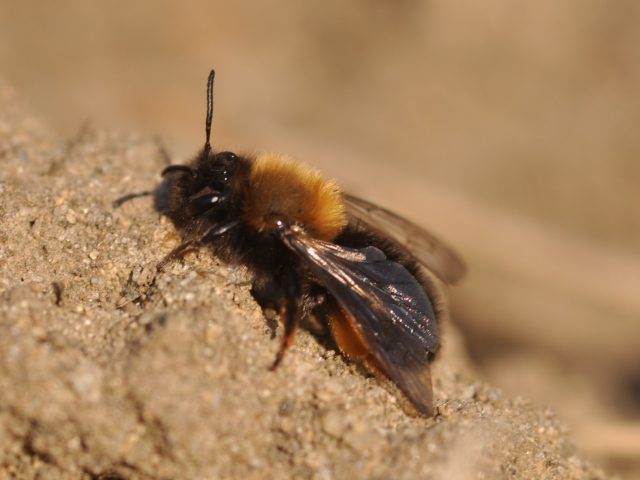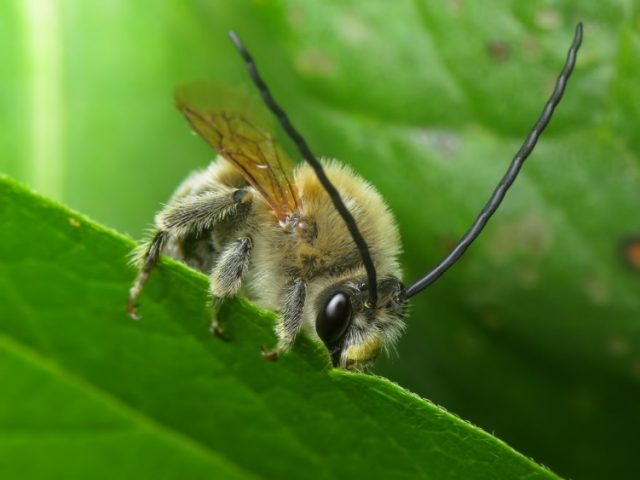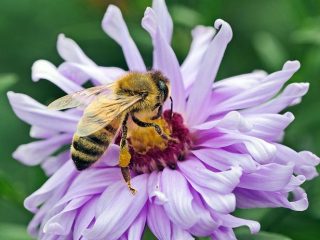Content
Ground bees are similar to ordinary bees, but they have a small population that prefers solitude in the wild. They are forced to coexist with humans due to the growth of urbanization.
Earth bees: photo + description
Based on the name, it should be taken into account that earth bees prefer to spend their time in the ground. They are bred in garden plots because they can cause harm to plantings, but the insects are listed in the Red Book.
Varieties
Bees are divided into species depending on color and lifestyle. They are united by their habitat: they prefer soil or bushes rather than trees.
Andrena-clarkella is a common species of earth bees, characterized by a variety of colors. There are black, blue and orange individuals, ranging in size from 8 to 17 mm, with pubescence on the head and back.
Andrena magna, habitat is the Black Sea coast, the species is listed in the Red Book. The length of the bee is 15-18 mm, it is black with purple wings, and the back is yellow. There are dense hairs on the head and body.
The long-haired bee, distributed from Europe to Kazakhstan, has a distinctive feature - the ability of two females to coexist simultaneously in a nest. Individuals are medium in size, grayish-yellow in color with long antennae.
Galictsphecodes are ubiquitous, similar in appearance to bees, but reddish or greenish in color. The size ranges from 5 to 15 mm.
Woolbites are small, well-fed bees that do not dig holes, but prefer to use ready-made ones. They are brown with yellow spots. A distinctive feature is the aggression of males towards other insects.
Leaf-cutter bees are solitary bees that construct a nest using leaf plates. They have strong jaws, but are unable to produce honey. They are protected by the Red Book of the Stavropol Territory.
Nomad: they are similar in appearance to honey bees, but are practically hairless and do not have an apparatus for collecting pollen. Their second name is cuckoo bees: they do not build nests, but breed in other people’s nests, borrowing supplies.
Mellitids are a type of earth bee similar to honey bees. Nectar is collected only from asteraceae and legumes.
The carpenter bee has a distinctive feature - its ability to buzz loudly. The insect is large in size, has blue wings with purple tints and dark blue eyes. Prefers a solitary existence.
Appearance
There are more than 1,500 subspecies. Many of them are monoviltine: capable of producing only one offspring per year. Some varieties produce 2 generations in a given period of time.
The difference between earth bees:
- small sizes: females 1.8-2 cm, males a few millimeters smaller;
- pubescence: thick fur allows the bee to survive in an earthen nest (it is colder in it than in a hive);
- color: insect wings with purple splashes, the head is often dark in color (black or brown), the body color is varied: there are individuals of green, orange or black shades.
The most important and basic difference is the desire to dig minks and build nests there.
Habitat
The location of the underground bee depends on the species. The habitat is widespread, with the exception of Oceania and South America.
They are capable of settling not only in wild conditions, but also in garden plots. They often act as pollinators and do not cause any harm to the garden. If there is no interference in their lives, they are peaceful.
Do bees live in earthen burrows?
Bees in the ground do not create numerous colonies: certain species are solitary, others prefer a chamber life.
The passage dug by the insect is no more than 80 cm in length, but is a network of semicircular tunnels, at the end of which there are “cells”. They are intended for breeding and filling with honey.
The colony is founded by the queen, who forms a future home from a burrow abandoned by the rodent.
To do this, she needs to perform the following steps:
- build a hole from loose soil, moistening the soil with saliva;
- line the “floor” of the hole with leaf plates;
- lay eggs;
- independently provide the larvae with nutrients until the offspring can obtain them on their own.
Such nectar is preserved in an earthen hive so that it does not lose its taste and healing qualities.
Features of reproduction
After arranging the nest, the queen equips wax chambers where she lays eggs. Some varieties of earth bees add grass fibers and crushed leaves to the cells.
When the laid larva begins to grow, the queen increases the size of the chamber so that the offspring can develop. As the young individuals mature, the queen dies. This is a characteristic feature of all earth bees. The female of the Galiktsfedox variety is able to adapt to frost and other bad weather conditions.
The younger generation continues to develop and harvest honey, dig minks and protect their homes.
How to get honey from ground bees
The life of the queen is short, as she strives to do everything before the end of the year. The females hatched in the last months of summer will begin creating new swarms and storing food as they grow older.
Honey from earth bees in the following stages:
- collecting nectar from flowers and plants;
- processing and placement of material into honeycombs;
- sealing the honeycomb for final ripening of honey.
It is possible to extract a healing substance from a hole, but it is associated with a number of obstacles: inconvenient location of honeycombs, active resistance of bees.
Before collection begins, insects are smoked out of the tunnels and then the hole is destroyed. This method is barbaric: without a hive, earth bees are left without a home and supplies, so the risk of their death is high.
Why are earth bees dangerous?
Despite the benefits of proximity to these insect representatives, they prefer not to be left in the garden plot.
This is due to the fact that, unlike their honey-bearing counterparts, earthen individuals are characterized by unpredictable behavior and can regard approaching their home as an attack.
In large numbers, the swarm leaves unsightly burrows, spoiling the landscape design, preventing the care of plants, and nibbling on leaf blades.
They pay special attention to carrots, celery, dill and onions. Underground bees are also capable of drinking nectar from cucumbers.
A good reason to get rid of ground bees on your property is the high risk of being stung.
How to get rid of ground bees
There are various methods for clearing an area of insects that are safe for both humans and plants.
Precautionary measures
The optimal time for the procedure is before sunrise or after sunset, when all individuals return to the hive to spend the night.
Before fighting earth bees, all strangers are removed from the area and put on a protective suit. A mask, rubberized gloves and thick clothing are required.
It is recommended to check for an allergic reaction to the poison before the procedure.
Several ways to remove earth bees from your site
The safest method is to invite a special group. You will need to indicate where the bees live in the ground and leave the area. Workers will move the hive into the forest, or use specialized preparations that are not available for sale to people.
Common ways to get rid of earth bees:
- Filling a hole with boiling water: you need to prepare 10-15 liters of liquid and pour it into the tunnel. This will lead to the death of insects.
- Treatment with pest control agents: if the attempt to get rid of the insects is unsuccessful, the insects will deliberately attack people, so the use of the products gives 100% results. Common drugs are Get, Delta Zone.
- Digging the soil: Shallow burrows can be destroyed by loosening the soil. In the case of a deeply hidden hive, there is a high risk of leaving insects alive that will attack humans.
One natural way to get rid of ground bees is to plant lavender bushes. The smell of the plant is very unpleasant for insects, which prefer to settle away from it.
Preventative work
To avoid being stung by an earthen bee, it is recommended to work in the area wearing covered clothing. You should not actively wave your arms or shout loudly.
Abundantly flowering and fragrant plants are a beacon for earth bees, so it is recommended to avoid them.
To prevent the swarm from returning, it is recommended to plant lemon balm bushes around the perimeter of the garden.
First aid for bites
If a bee attack is successful, the victim should be given medical assistance. The presence of an allergic reaction is the reason for immediate contact with a medical facility.
Providing assistance at home:
- the wound is examined and the sting is removed;
- cold is applied to the bite site to combat swelling and pain;
- the affected area is treated with Prednisolone or garlic, onions.
If possible, it is recommended to make a lotion from ammonia diluted in cold boiled water in a ratio of 1:5.
The use of antihistamines is mandatory: Suprastin, Zyrtec or Diazolin.
Difficulty breathing, swelling of the face and throat, rapid heartbeat are symptoms that require qualified assistance.The victim takes an antihistamine and is immediately sent to the hospital.
Conclusion
Ground bees are insects that are beneficial to the ecosystem, but their presence in the garden is a threat to humans. Peaceful coexistence is possible, but there is no guarantee that the insect will not attack. Timely disposal of bees and prevention of their appearance is a guarantee of preserving the site and peace of mind of the gardener.






















